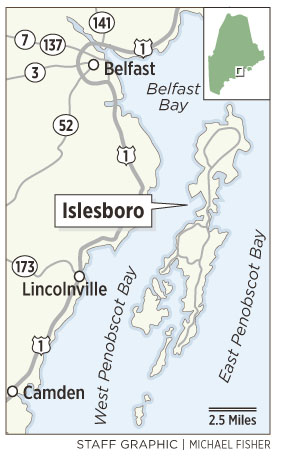ISLESBORO – Until now Islesboro’s fall hunting season was a throwback to a simpler time, with only bow hunting permitted.
But the island, just two miles from the mainland, will hold its first firearm hunt Dec. 10, when residents attempt to cull the herd on the 8,000 acres — or 12½ square miles — by themselves over the course of three weeks.
A dramatic increase in the number of Lyme disease cases on the island is leading residents to take matters into their own hands. They want to knock the herd down from as many as 60 deer per square mile to 10.
Culling an island deer population to reduce the risk of Lyme disease is not unusual. What makes Islesboro’s deer hunt unique is that residents are taking a do-it-yourself approach by crafting their own shotgun hunt in a place that has never had one.
“As far as anyone can remember, there has never been a firearm hunt there,” said regional wildlife biologist Keel Kemper in Sidney.
By a vote of 100-28, townspeople approved a firearm hunt open only to island residents (or their families) who pass a stringent hunting test and prove a shooting proficiency at the island’s gun range.
The Maine Department of Inland Fisheries and Wildlife’s Advisory Council signed off on Sept. 19.
Now state biologists and researchers are watching Islesboro closely to see whether the islanders can reduce the herd to a level that will reduce the number of Lyme disease cases.
Lyme disease is a bacterial infection spread through a deer tick bite, which can easily go undiagnosed due to the disease’s initial flu-like symptoms. But if left untreated, Lyme disease can cause severe joint pain and neurological problems.
Since 2003, a growing number of confirmed Lyme disease cases has been reported at Islesboro’s health center.
Islesboro’s year-round population is just 603, and grows to 1,500 in the summer.
In 2007, there were seven confirmed Lyme disease cases on the island. That grew to 18 in 2008 and to 27 in 2011, according to the town.
Culling a deer population on an island will reduce the incidence of Lyme disease because the tick that carries the disease needs deer as a blood host, said Peter Rand, at the Vector-borne Disease Laboratory at Maine Medical Center.
On Monhegan Island in 1996, a sharpshooter paid by the town eliminated the entire deer herd and the incidence of Lyme disease dropped to almost none.
But never before has a Maine island community taken upon itself the work of culling a herd to reduce the public health risk.
“The hunt is completely unique, but islands are particularly subject to Lyme disease because the deer have nowhere to go,” said Linda Gillies, who sits on Islesboro’s Tick-Borne Disease Prevention Committee. “Monhegan was our beacon, and Dr. Rand was our guru. None of us knew about Lyme disease before 2008.”
If successful, Isleboro’s hunt could serve as a model for other island communities.
“We’ve been at this business for a quarter of a century,” Rand said. “If we could find how far down you need to get the deer herd to see results, that could be a major public health advantage.”
DEER POPULATION HAS GROWN
For generations, Islesboro has held a bow hunt, with as many as 100 hunters participating. Despite that, the deer population has grown beyond what the habitat can support, Kemper said.
The browse line in the forests proves it, with buds stripped along the bottoms of trees throughout the island.
And when an island’s deer population explodes, so do cases of Lyme disease. That has been the case on Monhegan and Peaks islands.
On Islesboro, two deer pellet counts conducted in 2010 and 2011 showed between 50 and 60 deer per square mile, Kemper said.
The percentage of ticks collected on Islesboro that were carrying the Lyme disease bacteria has increased from 24 percent in 2006 to 49 percent in 2010, Rand said.
The medical community has generally believed that a deer population must be reduced to about 10 animals per square mile to effectively lower the percentage of deer ticks carrying the bacteria.
Rand said that’s never been proven in Maine, but the Islesboro hunt could confirm it.
“It’s a guess,” Rand said. “But there have been studies in Connecticut that show when you get below that density of deer, Lyme disease cases decrease. But that number needs to be nailed down. That’s why were interested in Islesboro.”
A QUIET CULTURE
Islesboro is 12 miles long, with a long cedar swamp in the center and ample woodlands throughout. The town center is nothing more than a crossroad. But Islesboro is a close-knit community.
The village has a modern, well-used community center; the renovated grade school, paid for with private money, overlooks the ocean; and a friendly, helpful spirit surrounds the ferry terminal.
When the town approved the shotgun hunt Aug. 24, it marked a significant milestone in the island’s history, and feelings remain mixed.
Islesboro native Barbara Pendleton is one of the 25 residents who voted against the hunt. Pendleton grew up in a hunting family — her father and uncles went to a deer camp in northern Maine every fall. But the planned large-scale reduction of the island’s herd upsets her.
“We don’t have much wildlife on the island,” said Pendleton, 67. “We’ve grown up with these creatures. They are so fun to observe.”
However, Fred Thomas, chairman of the town’s Deer Reduction Committee, said they have no choice.
“I was on the fence when we started,” said Thomas, a hunter and another island native. “It’s been no small task. We felt in order for people to be comfortable with it, we’d have to hold a shotgun hunt.” (A shotgun doesn’t shoot as far as a rifle.)
Summer resident Ken Senior, who contracted Lyme disease this summer, favors the hunt.
“After I got it, a lot of people on the island told me they had it,” said Senior, who lives in Waltham, Mass. “Some told me they had it twice. It should be a real call to action.”
Charlie Leighton, a summer resident from Middletown, R.I., is not a hunter but wants the herd culled.
“I know people who are really debilitated from the disease,” Leighton said. “I had a friend who used to play tennis who can’t play anymore. They’re wonderful animals, but there are just too many of them.”
DO-IT-YOURSELF APPROACH
Special deer reduction hunts requested by towns and approved by the state are not unusual. Other such hunts have taken place in Orono on Marsh Island, in Cape Elizabeth and in Wells at the Wells National Estuarine Research Reserve.
But on Islesboro the residents designed a very unusual Islesboro-only hunt, and they are in a position to offer an important case study, Rand said.
The hunters will have taken a test that included showing proficiency with a shotgun from 25 yards; and they’ll be responsible for killing as many deer as possible.
At least 30 approved hunters will take to the field from Dec. 10 to 31 for a whitetail hunt with no bag limit.
Then island residents and researchers will wait to see whether an island community on its own can lower the deer population density.
Rand said in similar island hunts, a sharpshooter or team of bow hunters was used to decrease the deer population. And at least in Monhegan’s case, the sharpshooter who removed 52 deer from the island in 1996 in a matter of days did so quickly and discreetly, but at a cost of $20,000.
Islesboro’s hunt is not cost prohibitive. It will take longer than Monhegan’s. But, Rand said, the do-it-yourself approach will work.
“I think there is some real hope for long-term lasting effects. They want to make it an exemplary hunt. They seem to be doing that,” Rand said.
Staff Writer Deirdre Fleming can be contacted at 791-6452 or at:
dfleming@pressherald.com
Twitter: Flemingpph
Send questions/comments to the editors.






Success. Please wait for the page to reload. If the page does not reload within 5 seconds, please refresh the page.
Enter your email and password to access comments.
Hi, to comment on stories you must . This profile is in addition to your subscription and website login.
Already have a commenting profile? .
Invalid username/password.
Please check your email to confirm and complete your registration.
Only subscribers are eligible to post comments. Please subscribe or login first for digital access. Here’s why.
Use the form below to reset your password. When you've submitted your account email, we will send an email with a reset code.